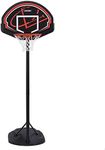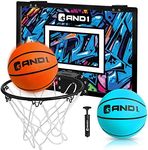Buying Guide for the Best Portable Basketball Hoops
Choosing a portable basketball hoop can be a fun process, but it's important to think about where and how you'll use it. Portable hoops are great because you can move them around and set them up in different places, like your driveway or backyard. When picking the right one, you should consider who will be playing (kids, teens, or adults), how often it will be used, and the space you have available. Understanding the main features will help you find a hoop that fits your needs and lasts a long time.Backboard SizeThe backboard is the flat surface where the ball bounces after a shot. Backboard size is important because it affects how realistic and enjoyable the game feels. Smaller backboards (around 44 inches) are good for younger kids or tight spaces, while larger backboards (54 inches and above) are better for teens and adults who want a more authentic experience. If you want to practice bank shots or play more competitively, a bigger backboard is usually better. Think about the age and skill level of the players and the space you have when choosing the size.
Backboard MaterialBackboards are usually made from materials like polycarbonate, acrylic, or tempered glass. Polycarbonate is durable and affordable, making it good for casual play and younger kids. Acrylic offers a better bounce and a clearer look, suitable for more serious players. Tempered glass is the top choice for a professional feel and the best rebound, but it's heavier and more expensive. If you want a hoop that feels like the ones in gyms, go for tempered glass, but for most families, polycarbonate or acrylic is a good balance between performance and durability.
Height AdjustmentHeight adjustment lets you raise or lower the hoop to suit different players. This is important if kids and adults will both be using the hoop, or if you want to practice different types of shots. Some hoops adjust in small increments, while others have preset heights. Lower settings (around 7.5 feet) are great for younger kids, while the standard height for adults is 10 feet. Choose a hoop with an easy-to-use adjustment system if you expect to change the height often.
Base Size and StabilityThe base holds the hoop upright and is usually filled with water or sand to keep it stable. A larger, heavier base means the hoop is less likely to tip over during play, which is important for safety. Smaller bases are easier to move but may not be as stable, especially for aggressive play or dunking. If you have strong players or expect a lot of action, look for a hoop with a big, sturdy base. If you need to move the hoop often, a lighter base with wheels might be more convenient.
Rim TypeThe rim is the metal ring where you shoot the ball. There are basic rims and breakaway rims, which have a spring mechanism that allows them to flex when someone dunks. Breakaway rims are safer and more durable for aggressive play, while standard rims are fine for casual shooting. If you expect dunking or rough play, a breakaway rim is a good choice. For simple shooting games, a standard rim will do the job.
PortabilityPortability refers to how easy it is to move the hoop around. Some hoops have built-in wheels and lighter bases, making them easy to roll to a new spot. Others are heavier and more stable but harder to move. If you plan to store the hoop away when not in use or move it between locations, look for one with good wheels and a manageable weight. If it will stay in one place most of the time, stability is more important than portability.
















